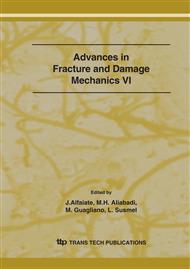p.145
p.149
p.153
p.157
p.161
p.165
p.169
p.173
p.177
Comparison of Computational Crack Path Predictions with Experimental Findings for a Quarter-Circular Surface Crack in a Shaft under Torsion
Abstract:
In this paper the rather complex 3D fatigue crack growth behaviour in a shaft with a quarter-circular crack under torsion is investigated by the aid of the programme ADAPCRACK3D and by application of a recently developed 3D fracture criterion. It will be shown that the computationally simulated results of fatigue crack growth in the FE-model of the shaft are in good agreement with experimental findings for the development of two anti-symmetric cracks, which originate from the two crack front corner points, that is where the crack front intersects the free surface of the cylindrical laboratory test-specimens. Consequently, also for this case with a rather complex 3D crack growth of two anti-symmetric cracks, the functionality of the ADAPCRACK3Dprogramme and the validity of the proposed 3D fracture criterion can be stated.
Info:
Periodical:
Pages:
161-164
Citation:
Online since:
September 2007
Authors:
Price:
Сopyright:
© 2007 Trans Tech Publications Ltd. All Rights Reserved
Share:
Citation:


